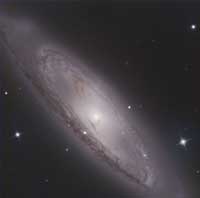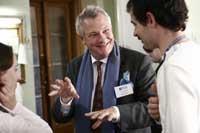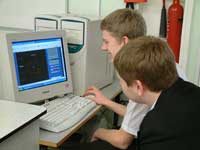The Faulkes Telescopes: real-time, remote-control astronomy for schools Teach article
Ever wanted to take a closer look at the stars? Rachel Dodds from the Faulkes Telescope Project explains how you can do just that – together with your students and without even leaving your classroom!
A study conducted by research and education stakeholders in the UK found that space has “a direct, positive effect on educational and career decisions” and that its inclusion increases motivation in science among students, regardless of gender, age, ability or culture (Spencer & Hulbert, 2006).
The Faulkes Telescope Project was launched in the UK in March 2004 and aims to engage students in real science using the largest entirely robotic telescopes in the world. There are currently two telescopes in operation: one on the island of Maui, Hawaii, and another at Siding Spring in New South Wales, Australia. Although they feature research-quality equipment, the Faulkes Telescopes were built primarily for educational users, with associated support and resources provided by the Faulkes Telescope team. The telescopes are controlled in real time by users via a simple websitew1 that delivers inspiring images of space to the classroom within minutes. This gives all students embarking on astronomy projects access to expertise and state-of-the-art equipment.

M65, taken and processed by
Nic Szymanek
Image courtesy of the Faulkes
Telescope Project
More than 450 schools in the UK are currently working with the Faulkes Telescope Project, taking images of distant astronomical objects. But the telescopes offer much more than just pretty pictures; it is when these images are processed that investigative science begins. Using Faulkes Telescope North (Hawaii), students have discovered new asteroids, observed supernovae, and studied other phenomena including mysterious gamma-ray bursts. Telescope targets can be tracked as they move across the sky, variations in brightness can be monitored, and even their chemical composition probed by using different filters. A group of UK schools is even helping astronomers to name an asteroid that they observed with Faulkes Telescope North – the first asteroid to be discovered using the Faulkes Telescopes. The real-time facility, unique to the Faulkes Telescopes, fosters a feeling of ownership over the images among the students. Couple this with the potential for real discovery that the telescopes offer, and the result is a powerful educational resource.
The Faulkes Telescopes can enhance the teaching of many subjects within the classroom, not only the sciences. The most obvious application is in physics, with topics such as light, Earth and the Solar System, and the life cycle of stars offering plenty of opportunity for telescope use, even within restrictive curricula. However, Faulkes Telescopes can also be readily linked to other subjects including information technology, chemistry and technology, and have been used in interdisciplinary projects combining the beauty of space with creative writing, art and design, and even music, dance and drama.

Russia was launched at
Sternberg Astronomy
Institute, Lomonosov Moscow
State University on 20
September 2006
Image courtesy of the Faulkes
Telescope Project
West Monmouth Comprehensive School in South Wales, UK, has been using the telescopes to support students with special needs to acquire basic proficiency in teamwork and presentation skills, while also studying towards a GCSE astronomy qualification (usually taken at the age of 16). The students demonstrated their new skills at a special event in Cardiff in October 2006 with an impressive presentation. Students use video conferencing to communicate with partner schools and astronomers. The lead teacher, Mr Kerry Pendergast, has been a keen amateur astronomer for many years. Speaking about these astronomy activities, he said: “The Faulkes Telescope Project has had a major impact on science at West Monmouth.”
The Faulkes Telescope Project does more than just facilitate telescope use: a comprehensive range of support materials and educational resources is also available. The website provides the real-time interface for controlling the telescopes and booking sessions, as well as advice for planning sessions, suggestions for suitable projects, podcasts and an image archive, and acts as a portal to many additional features.

Creation in the Eagle nebula
was taken by students from
Thomas Hills High School,
UK, and processed by Tommi
Warton, a technician at the
school
Image courtesy of the Faulkes
Telescope Project
In the UK, free teacher training days are offered at locations nationwide, covering a wide range of topics including image processing and science curriculum links. A new programme of online training is being trialled to complement these courses, and will be available internationally.
The educational arm of the Faulkes Telescope Project already extends beyond the UK. When NASA fired a copper ‘bullet’ into the Tempel 1 comet in 2005, the first images obtained from Earth were taken by a group of Faulkes Telescope North users from Hawaiian and Icelandic schools, working with Professor Alan Fitzsimmons’ team from Queens University in Belfast, Northern Ireland. Further small-scale projects have been established in Malaysia, Israel, Portugal and France, the latter two in conjunction with the European Union ‘Hands-On Universe’ projectw2. Since September 2006, a programme to monitor supernova explosions has been piloted by Polish schools, working through the British Councilw3. Students are involved in measuring changes in the brightness of supernovae – information that can help astronomers understand the processes that govern the death of massive stars.
Another, far larger, British Council-funded project, involving schools and astronomers from Russia, was launched in Moscow in September 2006w4. Twenty-four schools from five regions of Russia are working with local astronomers to study galaxies, asteroids and supernovae, and will make a genuine contribution to scientific knowledge. Dr Paul Roche, Director of the Faulkes Telescope Project, said: “Linking bright, motivated students with researchers [in Russia] will provide us with an ideal test of our plans for developing ‘real astronomy’ programmes across the world.” Dr Patrick Fullick from the School of Education at Southampton University, who co-ordinated the British Council project in Russia, believes that “Britain and Russia have much to learn from each other in the fields of science, mathematics and computer education, and closer links can provide great benefits to education in both countries.”

the telescope in real time
Image courtesy of the Faulkes
Telescope Project
The team also hope to partner UK schools with their counterparts overseas to facilitate the exchange of ideas, language skills and cultural awareness, via email, video conferencing and, potentially, visits. A major strength of the telescopes is their ability to promote collaborations not just between different schools in different locations, but also between schools and scientists.
In late 2005, the Faulkes Telescope Project became part of a much bigger programme, the Las Cumbres Observatory Global Telescope Networkw5. This will ultimately comprise 40 to 50 robotic telescopes of different sizes, spread across the globe, with several telescopes observing at any one moment, giving a truly global observatory. Although the larger instruments are primarily for research use, this network will also contain dozens of telescopes dedicated to educational use. In addition, the project will train local people to act as ‘ambassadors’ in their countries, and provide resources and facilities so that they will be able to train others in their area to use the telescopes.
Under the new umbrella of Las Cumbres Observatory Global Telescope Network, the educational programmes currently on offer in the UK through the Faulkes Telescope Project will expand internationally, making use of the increased access to telescopes and geographical locations.
Ultimately, the aim of Las Cumbres Observatory is to offer a free, supported service to users across the world, similar to that currently provided in the UK, and to enrich the education of students from many different cultures and backgrounds through access to exciting investigative science programmes.
Web References
- w1 – For more information about the Faulkes Telescope Project and how to use the facilities with your students, see: www.faulkes-telescope.com
- w2 – European Union Hands-On Universe (EU-HOU)
- w3 – The British Council Faulkes Telescope in Poland
- w4 – The British Council Faulkes Telescope in Russia
- w5 – Las Cumbres Observatory Global Telescope Network
Resources
- Beare R et al. (2003) Remote access astronomy. Physics Education 38: 232-236
- Beare R (2004) Astronomy-related content and robotic telescopes in upper secondary physics courses. School Science Review 86: 113-120
Review
This article introduces a wonderful hands-on astronomy activity, well known in the UK and gaining popularity all over the world. Faulkes Telescopes allows teachers and their students to operate a telescope directly from school, taking their own astronomical pictures and giving students an idea of what modern research in astronomy and physics is like.
Of most use to physics and astronomy teachers, the Faulkes Telescope facility also enables interdisciplinary projects, covering not only physics and astronomy, but information technology, image processing and foreign languages.
An international co-operation between schools, investigating a topic in astronomy or astrophysics, would be a perfect outcome of this article – and one that I would be happy to take part in.
Marco Nicolini, Italy





